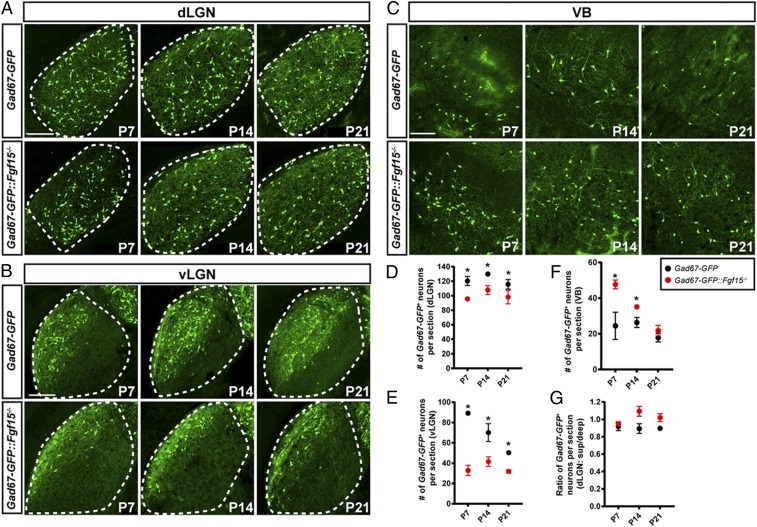Fig. 6.
FGF15 is required for Gad67-GFP+ interneuron recruitment into the visual thalamus. (A–C) Developmental distribution of GFP+ interneurons in dLGN (A), vLGN (B), and VB (C) of Gad67-GFP and Gad67-GFP::Fgf15−/− mice. (Scale bars, 70 µm.) (D–F) Quantification of the developmental distribution of GFP+ interneurons in the dLGN (D), vLGN (E), and VB (F) of Gad67-GFP and Gad67-GFP::Fgf15−/− mice. Data represent means ± SEM. Asterisks (*) represent significantly decreased interneuron number in Fgf15−/−::Gad67-GFP mutants compared to Gad67-GFP controls [in D, F(1, 48) = 38.8, P < 0.0001; Holm–Sidak post hoc test, all P < 0.006; in E, F(2, 72) = 64.45, P < 0.0001; Holm–Sidak post hoc test, all P < 0.001; in F, F(1, 48) = 19.97, P < 0.001; P7, P < 0.0001; P14, P = 0.033]. (G) Quantification of interneuron distribution within dLGN of Gad67-GFP and Gad67-GFP::Fgf15−/− mice as in Fig. 1E. Data points represent means ± SEM. No statistical differences were observed between Gad67-GFP::Fgf15−/− dLGN at different ages [F(2, 48) = 3.77, P = 0.301; Holm–Sidak post hoc test, all P > 0.552] or between mutant and control dLGN [F(1, 48) = 3.998, P = 0.512; Holm–Sidak post hoc test, all P > 0.378].

